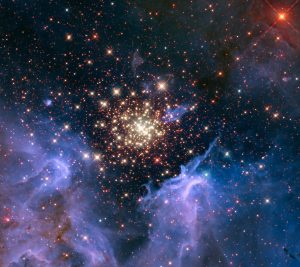Scintillio di Stelle
Una giovane, scintillante collezione di stelle si presenta come uno spettacolo celeste di fuochi d’artificio. L’ammasso è circondato da nubi di gas e polveri interstellari, la materia prima per la formazione di nuove stelle. La nebulosa, che si trova a 20.000 anni luce di distanza nella costellazione della Carena, contiene un ammasso centrale di stelle ardenti e massicce, chiamato NGC 3603.
L’ambiente circostante non è così pacifico come sembra. La radiazione ultravioletta e i violenti venti stellari hanno scavato un’enorme cavità nel gas e nella polvere che avvolge il cluster, permettendoci di ammirarlo in tutto il suo splendore.
Le stelle dell’ammasso sono nate in gran parte nello stesso periodo, ma si differenziano per dimensioni, massa, temperatura e colore. Il corso della vita di una stella è determinato dalla sua massa e un gruppo di una certa età conterrà stelle in varie fasi evolutive, fornendo l’opportunità di analisi dettagliate dei cicli di vita stellari.
NGC 3603 contiene alcune delle stelle più massicce conosciute. Queste stelle vivono una vita accelerata e muoiono giovani, bruciando in modo rapido e, infine, terminando la loro esistenza con esplosioni di supernova.
[ Barbara Bubbi ]
https://www.spacetelescope.org/images/opo1022a/
Credit: NASA, ESA, R. O’Connell (University of Virginia), F. Paresce (National Institute for Astrophysics, Bologna, Italy), E. Young (Universities Space Research Association/Ames Research Center), the WFC3 Science Oversight Committee, and the Hubble Heritage Team (STScI/AURA)

Lascia un commento